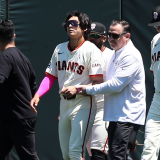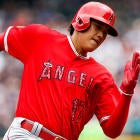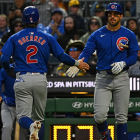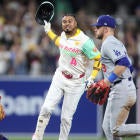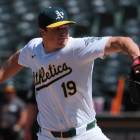While Major League Baseball as an industry has problems -- specifically on the labor and diversity fronts -- the game itself is in a solid place. Last season featured the emergence of myriad talented youngsters, including two-way phenom Shohei Ohtani, and intriguing (if somewhat flawed) strategies, like the opener. That newness, either in the form of players or ideas, helped fend off any staleness that can encroach over the 162-game regular season. It also inspired a question: What strategies would we like to see implemented heading forward?
Below you'll find four "bold" suggestions that are certain to not appeal to everyone. That's fine. Our goal here is just to give you something to think about during the boring portion of the winter.
1. Build like it's 2003
Not for nostalgia's sake, either.
Everyone accepts that there's value in zigging as everyone else zags. But that strategy is often embraced only when teams are on the cutting edge. It's safer to appear "smart" by taking the same approach as the top teams as opposed to going the other way entirely -- even if it means bypassing the opportunity to take advantage of obvious inefficiencies.
What we're proposing here, then, is the ultimate counterculture approach to roster-building. Don't do what the Los Angeles Dodgers, the Houston Astros and the Chicago Cubs are doing. Don't do what the Tampa Bay Rays and Cleveland Indians are doing. Rather, do what the Oakland Athletics did -- in 2003. Yes, forget about the last 15 years of evaluative shifts and pretend it's still the Moneyball era.
That means ignore defense and the third-time-through penalty. Focus on building a lineup of bat-only miscasts, a rotation of workhorses, and a bullpen of specialists. In practice, that means signing Robinson Chirinos (framing numbers be darned) and James Shields (because there's value in locking in 200 innings). That means trading for Jose Martinez and Domingo Santana and living with their poor gloves as a trade for their sticks. Go grab a couple left-handed and groundball specialists. And so on.
Would this work? Would it be enough to build a competitive roster? Probably not on its own -- after all, the teams who win aren't winning only because they recognized the importance of this or that first. It could help achieve that goal, however, if the acquisitions return a better yield than the market-confirming equivalent moves. Put another way, why compete with 24 other teams for the current fad when you could switch lanes and compete with a handful for an older one?
There's a chance it doesn't work at all and everyone involved looks dumber for it. But it'd be fascinating to see a team intentionally operate on a lag with the intent of being savvy.
2. Pair a two-way player with an opener
We have our qualms with the opener -- we can't help but wonder if it's just a wage-suppressing mechanism, and if the advantage gained is worth the headache -- but it seems like a good vehicle to use with a two-way player like Ohtani (who's recovering from Tommy John surgery) or Brendan McKay, of the Tampa Bay Rays.
Here's why.
Since both play for AL teams, they often aren't asked to bat on days they pitch. We propose foregoing the DH each time they're scheduled to pitch. The Angels or Rays would begin the game with a middle reliever on the mound, as is often the case with the opener. They would then pinch-hit for that spot in the order with Ohtani or McKay whenever it rolled around -- usually in the second or third inning. From there, the endgame is to have Ohtani or McKay throw six or so frames, bringing the game close to or to the point of completion.
What's the upside? Using this approach, the teams would gain two or three additional plate appearances from Ohtani or McKay they wouldn't get otherwise. Over 20, 25 starts, that can be 40 to 50 trips to the dish. That doesn't seem like a lot, but consider the leverage aspect. Just starting Ohtani or McKay without the DH means they're likely exiting before their spot takes its final at-bat. With the opener, Ohtani or McKay is more likely to be in the game when the seventh, eighth, or ninth inning rolls around. Depending on who they're hitting in place of, that could provide a decent boost in situational value.
There are some drawbacks, too. If Ohtani or McKay has a bad outing, then you risk burning your bench. The potential financial ramifications shouldn't be overlooked, either -- you'd rather not annoy one of your better players for some marginal advantage. But you can see the logic here. The question is whether either team with a two-way player would be willing to try it.
3. Shift less
Russell Carleton, a writer at Baseball Prospectus and formerly a member of Cleveland's front office, is one of the smartest public analysts out there. During the season, he released a book in which he notes that defensive shifts have not achieved their goal -- in part because they change how pitchers perform, causing them to be more walk-prone and less effective.
The funny thing about the seeming omnipresence of shifts is that it hasn't impacted the league-wide batting average on balls in play. Last season the league had a .296 BABIP, the lowest mark since 2011, when it hit .295 … which tied the previous recent low set in 2005. Get our point? If not, it's that shifts have become a staple over the past decade without curtailing hits on batted balls the way people suspect they do.
As a result, we say shift less. That doesn't mean give up on shading fielders -- the 2016 Cubs fielded a historic defense without positioning their fielders so aggressively as to have their alignments count as "shifts" by most measures -- it just means go for a subtle approach that isn't as likely to make your pitchers nervous. Even if it doesn't help, it probably won't hurt.
4. Steal more
The league averaged about 0.51 steals per game last season. That was the lowest rate since the early 1970s, nearly 50 years ago.
Anyone familiar with analytics knows the stolen base is a high-variance strategy. If you're succeeding less than three-quarters of the time, you're costing yourself runs. Fair enough. All the same, our argument isn't numbers-based so much as aesthetics-based. The stolen base is one of the most entertaining plays in baseball, offering a ton of possibility in just a few seconds.
We know, we know. This will probably go over as well as someone begging for fewer home runs and more seeing-eye singles. But really, the league is brimming with high-grade athletes. Let them run. Let them show off. Let them thrill us. The game is supposed to be fun, right?







